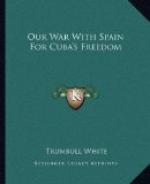Previous to the bombardment, orders were issued to prevent firing on Morro Castle, as the American Admiral had been informed that Lieutenant Hobson and the other prisoners of the Merrimac were confined there. In spite of this, however, several stray shots damaged Morro Castle somewhat.
Commodore Schley’s line moved closer in shore, firing at shorter range. The Brooklyn and Texas caused wild havoc among the Spanish shore batteries, quickly silencing them. While the larger ships were engaging the heavy batteries, the Suwanee and Vixen closed with the small in-shore battery opposite them, raining rapid-fire shots upon it and quickly placing the battery out of the fight.
The Brooklyn closed to 800 yards and then the destruction caused by its guns and those of the Marblehead and Texas was really awful. In a few minutes the woodwork of Estrella fort was burning and the battery was silenced, firing no more during the engagement. Eastward the New York and New Orleans silenced the Cayo battery in quick order and then shelled the earthworks located higher up. The practice here was not so accurate, owing to the elevation of the guns. Many of the shells, however, landed, and the Spanish gunners retired.
Shortly after 9 o’clock the firing ceased, the warships turning in order to permit the use of the port batteries. The firing then became a long reverberating crash of thunder, and the shells raked the Spanish batteries with terrific effect. Fire broke out in Catalina fort and silenced the Spanish guns. The firing of the fleet continued until 10 o’clock, when the Spanish ceased entirely, and Admiral Sampson hoisted the “Cease firing” signal.
After the fleet retired the Spaniards returned to their guns and sent twelve shots after the American ships, but no damage was done. In fact, throughout the entire engagement none of our ships was hit and no American was injured.
One purpose of Admiral Sampson, it appears, was to land troops and siege guns at Aguadores, after reducing the defenses of the place, and then make a close assault upon Santiago, which, in view of the present condition of its fortifications, may be expected to yield soon.
A landing of American troops was effected near Baiquiri, some distance east of Aguadores, and near the railroad station connecting with Santiago de Cuba. Later an engagement took place between the American force and a column of Spanish troops which had been sent against the landing party. The Spaniards were driven back.
The marines at Guantanamo.
Lieutenant-Colonel R. W. Huntington’s battalion of marines landed from the transport Panther on Friday, June 10, and encamped on the hill guarding the abandoned cable station at the entrance to the outer harbor of Guantanamo. On Saturday afternoon a rush attack was made on them by a detachment of Spanish regulars and guerrillas, and for thirteen hours the fighting was almost continuous, until re-enforcements were landed from the Marblehead.




